
Imagine a place of gentle density set against a backdrop of rolling hills. A neighbourly sense of community. A thriving local economy. Yes, some of this may sound a bit sentimental and rose-tinted, but if politics is about giving hope and fulfilling dreams, particularly of home-ownership, then high quality design is a minimum baseline and Conservative at its core.
With a long-term courageous approach, Conservatives can get on the front foot, own this crucial political battleground and flourish the flame of aspiration and home-ownership for decades to come.
Scepticism of new development and the impact that it will have on the identity of place is understandable. For too long we have tolerated mediocrity from developers and their identikit Lego-box developments which scar our landscapes without even so much as a subtle nod towards the existing architectural heritage, and with no thought towards what local people would want to see.
For these reasons, beautiful design is a top political priority at Wychavon District Council. Our rationale is simple. That the quality of the built environment determines the overall quality of life and the subsequent social and economic vibrancy of our places.
Since last summer we have been working with Create Streets to develop design codes that will set obligatory minimum standards for development – from the palette of bricks and materials that can be used; through to the property types and density that is appropriate for individual villages.
We must shift the narrative away from beautiful design being viewed as a cost but rather as an investment which returns increased health outcomes, a more attractive physical environment where businesses want to invest, complete with a captive engaged workforce who call the place home.
Beautifully designed places are uplifting and create a sense of well-being. Businesses choose to invest in them because of the attractiveness of the built environment and infrastructure that supports a healthy high-value workforce and increased productivity.
Whilst health, education, and other social indices are important metrics to measure, beautiful design and the policies which enable it are intrinsically linked to the government’s levelling up agenda.
We must support the private sector by creating new foundations for our future prosperity by striving to ensure that every £1 of public money spent on levelling up catalyses the maximum possible private sector investment into our towns, cities, and rural communities to ensure that they thrive.
Local planning departments should not be treated as isolated quasi-legal functions that are autonomous from the wider functions of any council.
A strong planning department and policy backdrop is the toolbox to unleash the economy and turbocharge the delivery of key priorities including job creation, new homes, and renewed town centre vibrancy with tourist appeal and a thriving night-time economy.
We should reward developers who seek to design locally distinctive schemes which boost the economic and social confidence of the places where they’re built.
Artisanal skills which are tucked away in rural business units repurposed from old farm courtyards or in small business workshops on the edge of market town industrial sites would play a starring role in crafting new communities whilst boosting the local economy and sometimes localising supply-chains.
At Wychavon we are positioning our planning department at the core of our delivery engine to cement our reputation as one of the UK’s best places to live and visit for years to come.
Ugly places, with a lack of meaningful supportive infrastructure breed contempt towards the system that created them and suppress aspiration and economic prosperity.
Bricks, materials, and aesthetics are foundational; our ambition must be bold. It is critical that we harness our rich and proud heritage and develop built infrastructure harmoniously and in adjacency to green infrastructure and landscaping priorities.
A more varied design palette is key. In Georgian market towns we should be approving new homes that have features as simple as sash windows and a visual symmetry.
Green open-space should be more integral, at the centre of developments in new rural extensions creating a modern village-green setting. Tree-lined streets should become the norm.
By focusing on development that is popular, aesthetically pleasing, and sustainable, we will create communities that attract residents and increase dwell times in our towns and villages. With unprecedented housing demand, all of the above is key to mitigating local fears and delivering new homes that existing people embrace and are proud to live near.
Future generations won’t reward mediocrity but they will reward a bold effort to stand up for our communities. For the sake of future generations, and to maintain our position as the natural party of home-ownership, we must seize the moment.
Published on Conservative Home on 20th June 2023




